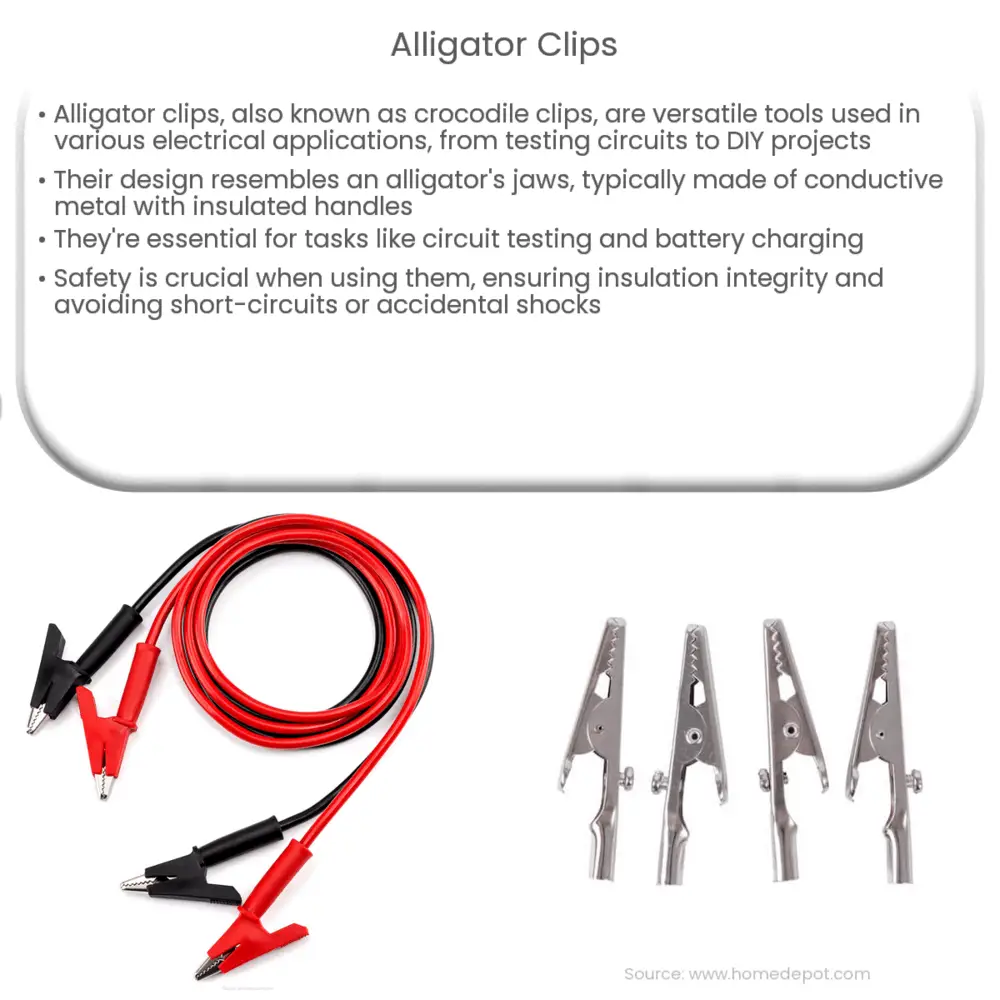Explore the versatile world of alligator clips – their characteristics, common uses, safety precautions, and tips for choosing the right clip.

Alligator Clips: An Essential Component in Electrical Connections
Alligator clips, also known as crocodile clips, are simple yet invaluable tools used in a variety of electrical applications. These compact, versatile devices have an array of uses, from creating temporary connections in electrical testing to serving as makeshift wire connectors in DIY projects. In this article, we will explore the characteristics, uses, and precautions associated with alligator clips.
Characteristics of Alligator Clips
The name “alligator clip” stems from its distinct design. When viewed from the side, the clip resembles the long, narrow jaws of an alligator or crocodile. Each clip typically has a spring-loaded hinge, which allows it to open and close its “jaws”. When the jaws are opened, they can clamp onto a conductor to create an electrical connection.
The body of an alligator clip is usually made of metal for conductivity, while the handles may be insulated to protect users from potential electric shocks. These clips come in various sizes to cater to different tasks.
Common Uses of Alligator Clips
- Testing electrical circuits: Alligator clips are a staple in the toolbox of any electrician or electronics hobbyist. They are often used to make temporary connections in an electrical circuit for testing purposes. In this context, they are typically attached to the ends of multimeter probes.
- Charging batteries: Alligator clips are often used to connect a battery to a charger or another battery for jump-starting purposes.
- DIY projects: In DIY electronics projects, alligator clips can be used to temporarily hold components together, providing a hands-free solution to testing or modifying a circuit.
Precautions When Using Alligator Clips
While alligator clips are highly useful tools, they should be used with caution. It is important to ensure that the insulating material on the handles is intact, especially when working with high voltage circuits. This helps prevent accidental electrical shocks.
Further, to prevent short-circuits, care should be taken to ensure that the bare metal parts of different alligator clips do not touch each other when connected to a live circuit. Finally, when using alligator clips for jump-starting vehicles, users should strictly adhere to safety guidelines to prevent sparks, which could potentially ignite battery gases.
Selecting the Right Alligator Clip
When choosing an alligator clip for your project or application, there are several factors to consider. These include:
- Size: The size of the alligator clip should be appropriate for the conductor it will be attached to. A clip that is too small may not make a secure connection, while a clip that is too large may be unwieldy.
- Insulation: The insulating material on the handles of the clip should be checked for integrity. Damaged or worn-out insulation can increase the risk of electric shock.
- Material: The body of the alligator clip should be made of a conductive material. Most often, this is metal, but the specific type of metal can affect the clip’s performance. For instance, copper has excellent conductivity, while stainless steel is more resistant to corrosion.
Conclusion
Alligator clips are humble but essential tools in the world of electronics and electrical work. Despite their simple design, they fulfill a crucial role in making temporary electrical connections, facilitating tasks like circuit testing, battery charging, and DIY projects.
While the use of alligator clips is generally straightforward, safety should always be the primary concern. Ensuring that clips are properly insulated and used in a way that minimizes the risk of short circuits is vital. With proper handling and selection, these small but mighty tools can greatly simplify your electrical tasks, while keeping safety firmly in focus.

